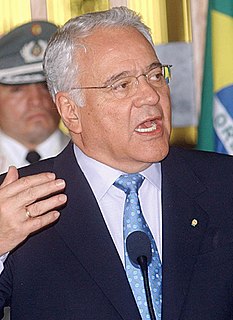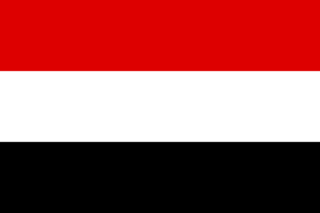
The politics of Bolivia takes place in a framework of a presidential representative democratic republic, whereby the president is head of state, head of government and head of a diverse multi-party system. Executive power is exercised by the government. Legislative power is vested in both the government and the two chambers of parliament. Both the Judiciary and the electoral branch are independent of the executive and the legislature. After the 2014 election, 53.1% of the seats in national parliament were held by women, a higher proportion of women than that of the population.

Carlos Diego Mesa Gisbert is a Bolivian historian and former politician. He was vice president of Bolivia from August 2002 to October 2003 and then became president, holding office from October 17, 2003 until his resignation on June 6, 2005. Mesa previously had been a television journalist. His widespread recognition prompted the MNR candidate Gonzalo Sánchez de Lozada to pick him as running mate in the 2002 Bolivian presidential elections. The winning ticket of Sánchez-Mesa took possession on August 6, 2002. As vice president, Mesa quickly was put into a difficult situation when a wave of protests and strikes shut down Bolivia in a bitter dispute known as the Bolivian Gas War. The demonstrations eventually forced Sánchez de Lozada to resign, leaving Mesa as president.

Jaime Paz Zamora was President of Bolivia from August 6, 1989 to August 6, 1993. He also served as Vice-President between 1982 and 1984.
The New Republican Force is a center-right political party in Bolivia. It is mainly based in the department of Cochabamba.

The Christian Democratic Party is a progressive Christian-democratic political party in Bolivia.

The Movement for Socialism–Political Instrument for the Sovereignty of the Peoples, alternately referred to as "Movement Toward Socialism" or "Movement to Socialism", is a Bolivian left-wing socialist political movement led by Evo Morales, founded in 1998. Its followers are known as masistas.

General elections were held in Bolivia on 18 December 2005. Evo Morales of the Movement for Socialism (MAS) party was elected President of Bolivia with 54% of the vote, the first time a candidate had received an absolute majority since the flawed 1978 elections. Morales was sworn in on 22 January 2006 for a five-year term. The MAS also won a majority of seats in the Chamber of Deputies and emerged as the largest party in the Senate.
After the fall of Tiwanaku empire, the many Aymara Lake Titicaca were conquered by the Inca empire. Prior to the Spanish conquest, the Andean province of Qullasuyu was a part of the Inca empire, while the northern and eastern lowlands were inhabited by independent nomadic tribes. Spanish conquistadors, arriving from Cuzco and Asunción took control of the region in the 16th century. During most of the Spanish colonial rule, Bolivia was known as Upper Peru and administered by the Royal Audiencia of Charcas. After the 1st call for independence in 1809, 16 years of war followed before the establishment of the Bolivian Republic, named for the Liberator Simón Bolívar, on August 6, 1825. Since then Bolivia has endured regular periods of political and economic instability, including the loss of various provinces to its neighbors, such as Acre, parts of the Gran Chaco and its Pacific coast, making it a land-locked country.

The domestic policy of the Evo Morales administration refers to the domestic policy initiatives of the current President of Bolivia, including past pre-presidential advocacies by Morales.
The history of Bolivia since 1982 begins with the restorations of democracy after the rule of the military junta of 1982. Evo Morales has held the presidency since 2006. A new constitution was enacted in 2009. Bolivia's population has roughly doubled over this period, from 5 million in 1980 to 10 million as of 2012.

General elections were held in Bolivia on 1 June 1997. As no candidate for the presidency received over 50% of the vote, the National Congress was required to elect a President on 4 August. Hugo Banzer of Nationalist Democratic Action (ADN) was subsequently elected. Whilst the ADN emerged as the largest party in Congress, it failed to win a majority of seats, and formed a coalition government with the Revolutionary Left Movement, Conscience of Fatherland and the Civic Solidarity Union.
Municipal elections were held in Bolivia, on December 5, 1999, in all 311 municipalities across the country. The elections marked a milestone in the continuous deterioration of the political influence of the traditional parties. In 23 municipalities the mayors were elected through direct popular vote, in other municipalities the mayors were elected by the respective municipal council.

The United Left was a political coalition in Bolivia. IU was launched ahead of the 1989 national elections, as a successor of the United People's Front (FPU). At the time of its founding IU consisted of eight parties, including the Revolutionary Left Movement - Free Bolivia (MIR-BL), the Communist Party of Bolivia (PCB), the Socialist Party-1 (PS-1), the Axis of Patriotic Convergence (ECP), the Movement for Socialist-Unzaguist (MAS-U) and FOM.

General elections were held in Bolivia on 7 May 1989. As no candidate for the presidency received over 50% of the vote, the National Congress was required to elect a President on 6 August. Although the Revolutionary Nationalist Movement had received the most votes, its candidate for President Gonzalo Sánchez de Lozada was defeated by Jaime Paz Zamora of the Revolutionary Left Movement (MIR) in the Congressional vote, despite the MIR only finishing third in the public vote.

General elections were held in Bolivia on 6 June 1993. As no candidate for the presidency received over 50% of the vote, the National Congress was required to elect a President on 4 August. Gonzalo Sánchez de Lozada of the Revolutionary Nationalist Movement–Revolutionary Liberation Movement Tupaq Katari alliance was subsequently elected unopposed.

The Bolivian general election, 2014 was Bolivia's second to take place under the country's 2009 constitution, and the first supervised by the Plurinational Electoral Organ, a newly created fourth branch of government. Incumbent President Evo Morales was re-elected for a third term.






















